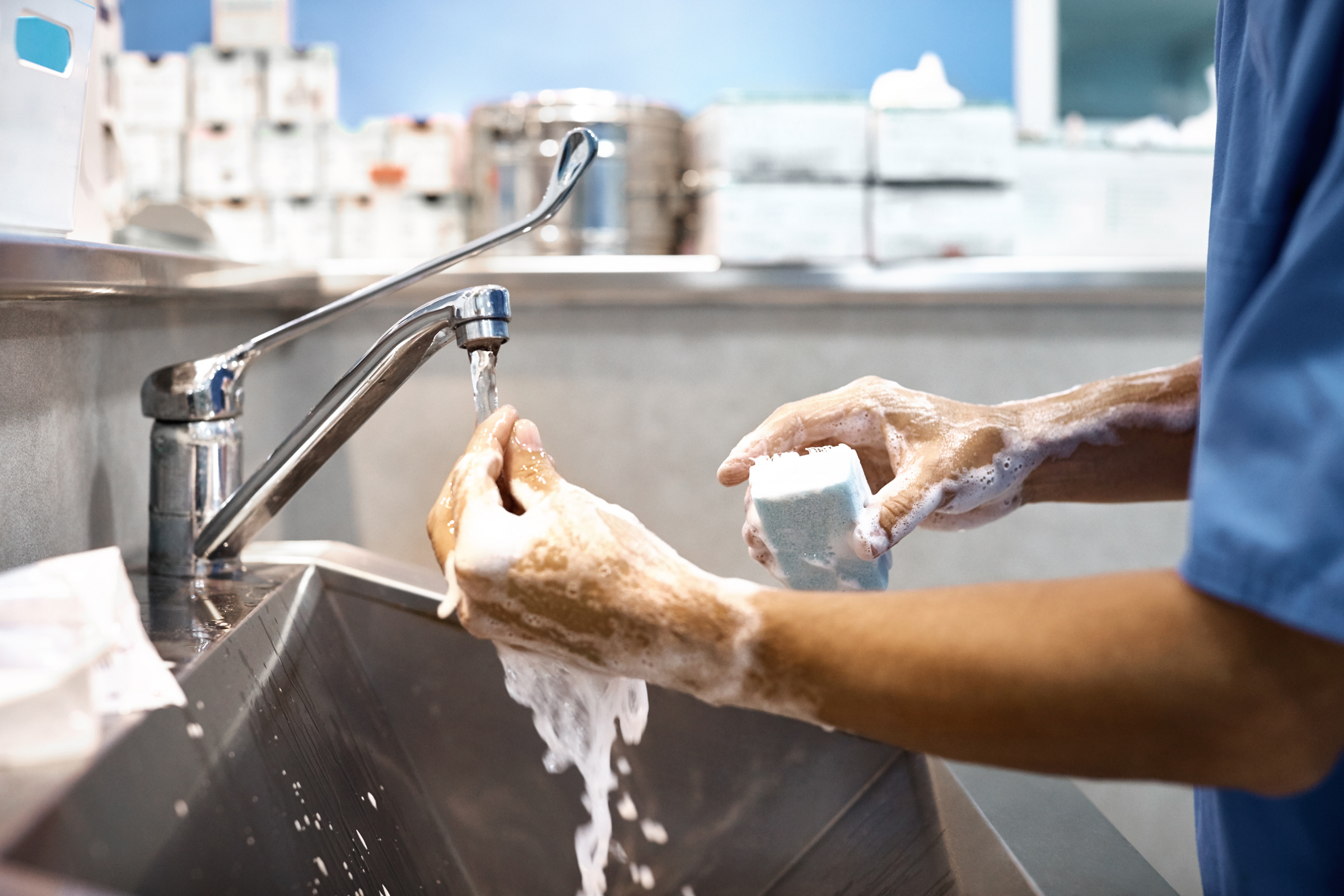
Each workday of an equine practitioner is filled with patients and clinical obligations. Time is often in scarce supply. Good hand hygiene is paramount to minimizing infection; however, this is a time-consuming procedure in many instances. Not only is it critical to have clean hands prior to surgical procedures, but also in the clinic and in the field, whether you are cleaning wounds, changing bandages or performing clinical exams.
Historically, hand preparation prior to surgery has relied on scrubbing with water and antiseptic soap (chlorhexidine (CHX) or povidone-iodine (PVP)) for 10 minutes or more. For normal hand-washing, it is suggested to sing the Happy Birthday song in entirety three times while scrubbing to ensure appropriate time of skin contact with soap and water.
Some pitfalls to hand washing with antiseptic soap and water are presented in a comprehensive overview of evidence-based research from human hospital studies [Verwilghen, D. The World Health Organization’s Clean Hands Save Lives: A concept applicable to equine medicine as Clean Hands Save Horses. Equine Veterinary Education 2018, vol 30, no. 10; pp. 549-557]. The review brings to light a more effective and considerably less time-consuming hand cleansing method that can be easily applied by equine practitioners and their staffs.
Hand washing many times during the course of the day tends to irritate and dry out the skin as well as having the potential to create microdamage to the skin that could promote colonization of bacteria; this is counterproductive to the objective of removal and/or kill of transient microorganisms. In addition, the presence of dry or irritated skin reduces a practitioner’s motivation to wash his or her hands as frequently as necessary.
It is important to recognize that acquired antimicrobial resistance is not just emerging against antibiotic drugs but also against antiseptics, and in particular chlorhexidine. Many studies have demonstrated that “the antibacterial efficacy of products containing high concentrations of alcohol significantly surpasses that of any medicated soap.” Bacterial regrowth on the skin after use of alcohol-based hand rubs (AHR) takes about six hours.
Ideally, application of alcohol-based hand rubs should follow pre-washing when there is visible contamination. In the equine world, contamination with large debris or fluids is all too common considering the nature of the business.
The journal review then recommended using a short hand-wash with gentle, pH neutral and non-medicated soap to remove organic debris and body fluids. Prior to the hand-cleansing ritual, all jewelry should be removed as well as a wristwatch that might preclude thorough cleansing for fear of getting the watch wet. Also mentioned was that it is best not to use nail polish and the nails should be kept short and clean. After complete drying of the hands, an alcohol-based hand rub is applied and rubbed in for a specified time, usually 1-1½ minutes.
One trial looked at the efficacy of an alcohol-CHX combination and found it more superior than just a hand wash.
In another recent equine study, several techniques were compared for hand cleaning where soiling occurred over about 20% of the skin surface:
- 30 second hand rub with alcoholic or nonalcoholic rubbing solution;
- 60 second hand rub with alcoholic or nonalcoholic rubbing solution;
- 1-minute hand-wash with neutral soap alone and together with 30-second alcoholic rub.
The best efficacy was achieved from the combination of hand wash with 30 seconds of an alcohol-based hand rub. The other two hand rub procedures proved better at cleansing than a simple hand wash with just soap.
The conclusion of this trial stated that in the absence of water, 30-60 seconds with an alcohol-based hand rub is an alternative to soap and water for achieving good hand hygiene where hands are visibly soiled.
The World Health Organization (WHO) stipulated the importance of hand hygiene: a) before touching a patient; b) before a clean/aseptic procedure; c) after body fluid exposure; d) after touching the patient; and e) after touching the patient’s surroundings. Use of moisturizing creams following procedures helps minimize skin irritation and dryness.
These research studies give equine practitioners and their staffs in the field and in a clinic setting an effective method to minimize infection in their patients. Using a short period of an alcohol-based hand rub application has the potential for greater compliance than the historical 10-minute antiseptic soap and water scrub veterinarians have been taught in the past.








